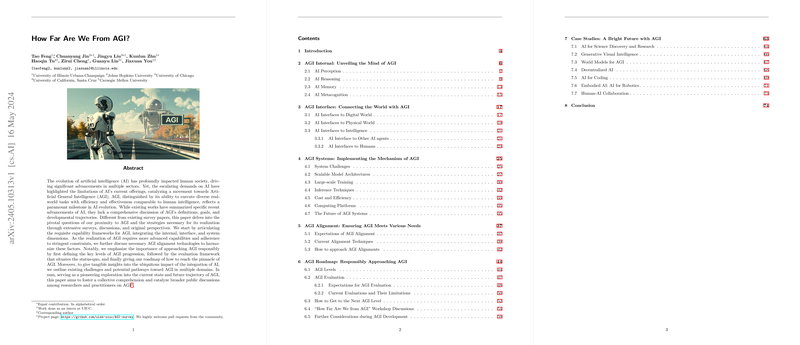Demystifying the Path to AGI: Insights and Implications
Introduction
The progression of AI into what many call AGI marks an ambitious milestone in AI's evolution. Unlike traditional AI, AGI aims to perform a variety of tasks with human-like efficiency and effectiveness. In a comprehensive discussion, a paper dives into key aspects such as definitions, capability frameworks, and strategic roadmaps, laying out where we stand and what lies on the path to AGI.
AGI’s Core Capabilities and Frameworks
Perception
AGI perception involves interpreting sensory information from various inputs—text, images, videos, and more. Current models like GPT-4 and Gemini excel in NLP and vision, thanks to advancements in multi-modal intelligence. Although many models can interact across different data types, challenges like robustness and handling adversarial examples persist. Future research suggests better integration of diverse data types and enhancing model robustness to adversarial inputs while prioritizing transparency and explainability.
Reasoning
AI reasoning encompasses logical and systematic thinking to draw conclusions or make decisions. Techniques like Chain of Thought (CoT) and Tree of Thoughts (ToT) have significantly improved reasoning outcomes by enabling complex problem decomposition. Moving forward, areas like self-consistency in reasoning and dynamic reasoning and planning offer promising avenues for more reliable AI systems. However, the journey demands models capable of understanding and applying causation, handling long contexts, minimizing hallucinations, and enhancing social reasoning.
Memory
AI memory, divided into short-term and long-term categories, is crucial for maintaining information needed for decision-making. Efficient memory retrieval and the integration of retrieval procedures with reasoned actions embody future goals for AGI memory systems. Decentralized memory and autonomous self-updating knowledge banks will bolster AI’s capacity for continuous learning and adaptation.
Metacognition
Metacognition, or the ability to understand and regulate one's own cognitive processes, will be key in future AGI systems. Developing self-awareness, managing complex tasks, and evolving independently without human intervention highlight the long-term objectives for AGI metacognition. Despite promising developments, challenges like handling ambiguity, ensuring ethical design, and fostering advanced social reasoning remain.
AGI Interfaces: Bridging the Digital and Physical Worlds
AI Interfaces to the Digital World
Modern AI agents can navigate and utilize a variety of digital tools efficiently. Implementations like Toolformer and frameworks for managing digital environments such as Mind2Web reflect substantial progress. To break new ground, extending these capabilities to include a wider range of digital interaction scenarios and congruently managing the ethical use of digital tools is essential.
AI Interfaces to the Physical World
Robotic control, navigation, and interaction capabilities have shown significant strides. Systems like GPT-4 with visual perception and manipulation abilities indicate progress towards integrating AI into real-world environments. Deploying efficient algorithms in resource-constrained settings and leveraging edge computing will be pivotal in broader adoption.
AI Interfaces to Intelligence
Bringing in other AI and human agents, AGI must excel at collaborative environments. Techniques such as prompt engineering and robust interaction protocols ensure that AGI systems operate harmoniously with other intelligent systems. Focus on advanced communication frameworks, robust interaction protocols, and secure collaboration will be central to development.
AGI Systems: Engineering Scalability and Efficiency
Scalable model architectures, large-scale training frameworks, and optimized inference techniques underscore the backbone of AGI systems. Diverse approaches include:
- Model compression: Techniques like knowledge distillation and parameter-efficient fine-tuning methods (e.g., LoRA).
- Memory management: Efficiently managing resources with methods like adaptive KV cache compression.
- Parallel computing: Automatic parallelism scheduling and combining tensor parallel, model parallel, and pipeline parallel strategies.
AGI Alignment: Ensuring Ethical and Practical Utility
Aligning AGI to human values involves careful consideration of ethical implications, data bias, transparency, and robust safety mechanisms. Current methods like RLHF (Reinforcement Learning from Human Feedback) and scalable alignment approaches offer sound frameworks. However, advanced AGI systems will need alignment that integrates more deeply with human-centric goals and ethical standards.
AGI Roadmap: From Definition to Realization
Comprehensive stratification into Embryonic AGI, Superhuman AGI, and Ultimate AGI helps in charting the progression trajectory. Moving towards AGI necessitates improved model evaluation frameworks, efficient data economy, and interdisciplinary cooperation. Understanding AGI's practical implications across various domains, from scientific discovery to real-world robotics, highlights the potential and pitfalls alike.
Conclusion
The path to AGI, while challenging, is lined with promising advancements and emerging frameworks. Key focuses remain on enhancing core capabilities, developing sophisticated interfaces, ensuring ethical alignment, and fostering a responsible approach. AGI's potential to revolutionize everything from everyday tasks to scientific breakthroughs hinges on collective collaboration, innovative research, and stringent safety standards. The journey towards fully realized AGI remains in its early stages, but with continued dedication, we can envision AGI as a transformative force for greater societal benefit.
